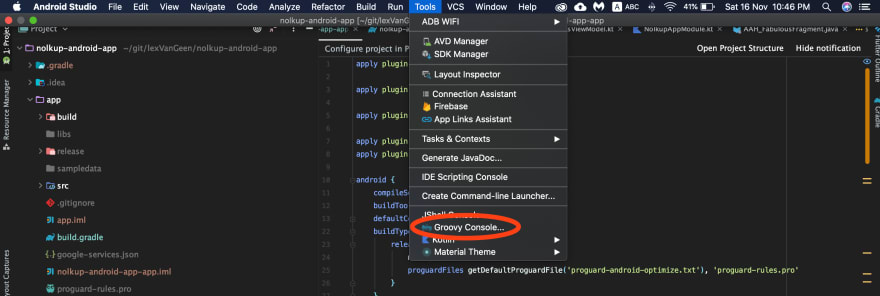
- #ANDROID STUDIO GRADLE MENU HOW TO#
- #ANDROID STUDIO GRADLE MENU APK#
- #ANDROID STUDIO GRADLE MENU INSTALL#
- #ANDROID STUDIO GRADLE MENU ANDROID#
Here you can verify your settings for the emulator AVD that will run your emulated device.
#ANDROID STUDIO GRADLE MENU ANDROID#
Use the Back button to navigate out of the installation dialogs and back to the Android Virtual Device (AVD) panel. Click Finish when installation is complete (click to enlarge)īefore continuing, it's a good idea to check your work. At this point, the system image components are being downloaded and installed. After accepting the license agreement, you will be presented with the Component Installer panel. You must accept the license agreement to continue. Accept the license agreement and click Next (click to enlarge)
#ANDROID STUDIO GRADLE MENU INSTALL#
Before you can install the system image, you will also be presented with a license agreement. You'll need to click the Download link to download whatever system image you've chosen. Select a system image for device emulation (click to enlarge) I clicked the Other Images tab followed by IceCreamSandwich - the highlighted line in Figure 5. The resulting System Image panel invites you to select a system image for this device emulation. Click Next after you've made your selection. For this example, I selected the highlighted (default) Nexus 5X. Select whatever device you want to emulate. Use the Virtual Device Configuration dialog box to choose a device to emulate (click to enlarge) Clicking Create New Virtual Device launches the dialog box shown in Figure 4. In this case, Android Studio hasn't detected any connected USB devices or emulators, so you'll need to configure a new virtual device. Select the device or emulator to run the app (click to enlarge) Android Debug Bridge (ADB) must be initialized in order to run an Android app (click to enlarge)Īfter you've initialized the Android Debug Bridge, the message in Figure 2 will be replaced by a list of all connected USB devices and running emulators that have been detected by Android Studio. Either way, Android Studio responds with the Select Deployment Target dialog box. Alternatively, you can click the green triangle button on the toolbar. You can run the example application (W2A) or any other app by selecting Run 'app' in the Run menu. Run your Android app on an emulated device

For my example I'll be using an Amazon Kindle Fire HD tablet, but the instructions should generally apply to the device of your choice.
#ANDROID STUDIO GRADLE MENU HOW TO#
In this section I'll show you how to run an Android application two ways: first on an emulated device, and then on an actual device.
#ANDROID STUDIO GRADLE MENU APK#
For example, you could use the Generate Signed Bundle / APK menu item to build a signed app bundle or APK. Do more with the Build menuĪndroid Studio's Build menu lets you perform several build tasks. If necessary, Gradle will automatically rebuild the app before its APK is installed and the app is run. Another approach is to actually run the app. For example, you could select Rebuild Project from the Build menu. There's more than one way to build an Android app. The event log reveals no problems (click to enlarge)

Following image shows the default build types. In the release build type, we obfuscate the code using ProGuard to prevent reverse engineering. The release builds are meant to be uploaded to the play store. A release is the build type that requires you to sign the APK. Debug is the build type that is used when we run the application from the IDE directly onto a device. Once the new project is created, by default it consists of two build types/variants - debug, release. In the next section, we’ll look at build types. Create a new project in your Android Studio and choose the Basic activity. These differences can be as small as changes in themes and app icons or can be for different stages of the product such as dev, beta, production etc.

We’ll see how they make our Android Development easier and faster especially when we’re creating applications with minimal differences. In this tutorial, we’ll be discussing Android Build Types and Product Flavors.


 0 kommentar(er)
0 kommentar(er)
